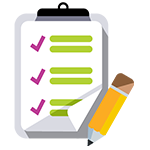Preparing for the Texas Success Initiative Assessment 2.0 (TSIA2)
The Texas Success Initiative (otherwise known as the TSI) was initially established in 2003, aiming to assess the academic skills of incoming college students across the Lone Star State. The TSI required students to complete assessments in three standalone subject areas: mathematics, reading, and writing, helping to place those students in appropriately leveled college courses and ensuring students were enrolled in remediation courses when necessary.
In 2021, the TSI was updated to create the Texas Success Initiative Assessment 2.0 (or the TSIA2)—a new reiteration of the assessment that would be a stronger representation of students’ skills while minimizing the time taken on standardized testing. Except for students who have exemptions, all aspiring college-goers in the state of Texas must complete the TSIA 2.0 to enroll in college courses–so knowing precisely what the assessment entails is critical in students putting their best efforts forward.
Key Things to know about the TSIA 2.0
The content included on the TSIA2 is largely the same as that tested on the previous TSI assessment. For instance, the TSIA2, like its predecessor, pulls academic standards for its questions from the Texas College and Career Readiness Standards, the Texas Essential Knowledge and Skills (TEKS) for Algebra II and English III, and the Texas Adult Education and Literacy Content Standards 2.0 (AEL Standards, 2.0). However, there are several adaptations in the assessment that influence the testing experience. For one, the reading and writing assessments have been combined into a comprehensive English Language Arts Reading (ELAR) section, while Mathematics remains a standalone test.
The TSIA2 ELAR assessment consists of a suite made up of:
- “a single multiple-choice college readiness classification (CRC) test, providing (in conjunction with the Essay Test) information regarding test takers’ college readiness in reading and writing;
- a single multiple-choice Diagnostic Test, providing information regarding test takers’ academic strengths and weaknesses in reading and writing; and
- a constructed-response Essay (known as the WritePlacer®).”
College Board, 2021
The TSIA2 Mathematics assessment consists of a suite that includes:
- “a multiple-choice college readiness classification (CRC) test, providing information regarding test takers’ college readiness in mathematics; and
- a multiple-choice Diagnostic Test, providing information regarding test takers’ academic strengths and weaknesses in mathematics.”
College Board, 2021
Aside from the general design of the assessment content, below are some other important characteristics of the TSIA2 to familiarize yourself with.
Computer Adaptive Testing Format
One of the key features of the TSIA2 is its adaptive testing mechanism, which means that questions increase or decrease in difficulty level depending on how test takers respond to each item. Unlike traditional standardized tests, which follow a fixed format for all students, adaptive testing adjusts the difficulty level of questions based on the test taker’s responses. This personalized approach provides a more accurate assessment of an individual’s skills and knowledge by adjusting based on students’ performance.
Expanded Content Coverage
TSIA2 encompasses an expanded range of questions within its tested content areas, reflecting the diverse skillset required for success in higher education. In addition to assessing foundational reading, writing, and mathematics skills, the new assessment includes questions that require critical thinking and problem-solving abilities, thinking that is more closely aligned with what is expected within a college classroom. This holistic approach aims to better assess students on the expected rigors of college academics.
Untimed and Pausable (Mostly)
The TSIA2 is an untimed test, which means there is no time limit on how long students can take to complete the assessment. Test takers can even start and stop anytime during the test session by using the “Save and Finish Later” option, as long as their test session is completed within 13 calendar days. Importantly, this is not an available option in the essay section (WritePlacer®) of the ELAR suite, during which students must begin and complete their essays within the same session.
In almost all cases, the TSIA2 immediately provides testing results upon completion, and test takers will instantly receive information on their scores, as well as their strengths and weaknesses.
Online Test Delivery
The TSIA2 is designed to be administered electronically. This online delivery not only enhances accessibility and convenience but also aligns with the digital literacy skills essential for success in today’s interconnected world. According to an announcement by the Texas Education Agency (TEA), online delivery for TSIA2 aims to provide a seamless testing experience for students while leveraging technology to streamline the assessment process.
Required Unless Otherwise Exempt
The TSIA2 is a required assessment for those hoping to enroll in college courses in the state of Texas. However, there are several exemptions through which students could enroll without completing this assessment. Aspiring college students might be exempt from the TSIA2 if they:
- Have met the minimum college readiness standard on the SAT®, ACT, or the English III/Algebra II STAAR End-of-Course high school tests;
- Have successfully completed college-level course(s);
- Have enrolled in a Level-One certificate program (fewer than 43 semester credit hours);
- Are not seeking a degree; or
- Have been, or currently are, in the military.
Overall, the Texas Success Initiative Assessment 2.0 represents a comprehensive and adaptive approach to evaluating students’ readiness for college-level coursework, incorporating expanded content coverage and online delivery to better align with modern educational standards and instructional methodologies. These differences mark a significant advancement in student assessment compared to its predecessor, the Texas Success Initiative Assessment.
PREPARING FOR EACH SECTION OF THE TSIA2
Preparing for the Texas Success Initiative Assessment 2.0 (TSIA2) requires a strategic approach to ensure readiness for the assessment’s content areas. Firstly, students should familiarize themselves with the structure and format of TSIA2, including the types of questions they will encounter in each section. By reviewing sample questions and practice tests provided by official sources, such as the Texas Higher Education Coordinating Board (THECB), students can gain insight into the assessment’s requirements and assess their proficiency levels across subject areas.
Students should prioritize skill-building in areas where they may need additional support. For instance, if a student struggles with mathematics concepts covered in the TSIA2, they can utilize online resources, instructional videos, and practice exercises to reinforce their understanding of fundamental mathematical principles. Educational platforms like Khan Academy and College Board, and of course, Progress Learning, offer interactive resources tailored to improve students’ academic skills and prepare them for college-level coursework.
To best prepare for the TSIA2, students should know precisely what types of questions and tasks they will be given. An overview of question types and content focuses can be found below.
English Language Arts Reading (ELAR)
The ELAR section of the TSIA2 presents two different types of question categories to gauge students’ still across reading and writing via multiple-choice questions. These include:
- Reading-focused questions that measure test takers’ skills in comprehension and analysis of literary texts, as well as informational and argumentative texts, including paired passages.
- Writing-focused questions that measure test takers’ skills in the revision and editing of sentences, paragraphs, and early drafts of essays.
Essay (WritePlacer®)
In this section of the TSIA2, test takers are tasked with a prompt that they must address in a formal written essay. Completed essays are then scored based on the following criteria:
- Purpose and Focus: The extent to which the writer presents information in a unified and coherent manner, clearly addressing the issue
- Organization and Structure: The extent to which the writer orders and connects ideas
- Development and Support: The extent to which the writer develops and supports ideas
- Sentence Variety and Style: The extent to which the writer crafts sentences and paragraphs demonstrating control of vocabulary, voice, and structure
- Mechanical Conventions: The extent to which the writer expresses ideas using Standard English conventions
- Critical Thinking: The extent to which the writer communicates a point of view and demonstrates reasoned relationships among ideas
Mathematics
The mathematics section of the TSIA2 includes multiple question types that span the following mathematical areas of focus.
- Quantitative Reasoning: Calculating ratios, proportions, and percentages, as well as identifying, manipulating, and interpreting linear equations and expressions
- Algebraic Reasoning: Solving equations (linear, quadratic, polynomial, exponential, rational, and radical), evaluating functions, and solving algebraic problems in context
- Geometric and Spatial Reasoning: Converting units within measurement systems, solving geometric problems (perimeter, area, surface area, and volume), performing transformations, and applying right triangle trigonometry
- Probabilistic and Statistical Reasoning: Classifying data, constructing appropriate representations of data, computing, and interpreting probability, and describing measures of center and spread of data
Takeaways
Based on the information provided, students should determine their areas of weakness to build their skills for the TSIA2, as well as their overall understanding of the design of the assessment. While the TSIA2 is a helpful tool in placing students in the appropriate college courses, it is important to recognize the reality that poor performance on the TSIA2 can lead to placement in remediation courses, adding time and financial duress to students’ college careers. As such, preparation for this assessment is critical.
Are your students fully prepared for the Texas Success Initiative Assessment 2.0 (TSIA2)? Progress Learning is here to support you in ensuring their success!
Progress Learning’s Texas high school program has TSIA2-aligned questions and item types, tailored to elevate student performance in English Language Arts and Reading (ELAR) and Mathematics. Our materials are designed to empower students with targeted preparation, equipping them to excel on this crucial assessment.
References
- College Board. Texas Success Initiative Assessment: Interpreting Your Score. https://reportcenter.highered.texas.gov/reports/data/crs-tsia-interpreting-your-scores/
- College Board. Texas Success Initiative Assessment 2.0: Student Informational Brochure. https://accuplacer.collegeboard.org/accuplacer/pdf/tsia2-student-informational-brochure.pdf
- College Board, prepared for the Texas Higher Education Coordinating Board. 2021. TSIA2
- Mathematics Test Specifications (Version 1.4). https://reportcenter.highered.texas.gov/training-materials/tsia2-math-test-specifications-v1-4/
- College Board, prepared for the Texas Higher Education Coordinating Board. 2021. TSIA2 ELAR Test Specifications (Version 1.4). https://reportcenter.highered.texas.gov/training-materials/tsia2-elar-test-specifications-v1-4/
- Texas Higher Education Coordinating Board. “Texas Success Initiative Assessment (TSIA) 2.0.” https://www.thecb.state.tx.us/index.cfm?objectid=E876AB94-EB44-4385-BCB2FADAC4254C1D
- Texas Education Agency. “Texas Success Initiative (TSI).” https://tea.texas.gov/academics/college-career-and-military-prep/texas-success-initiative-tsi
- The TSI Assessment vs. the TSIA2: What’s the Difference? Union Test Prep. https://uniontestprep.com/tsia2/resources/the-tsi-assessment-vs-the-tsia2-what-s-the-difference


